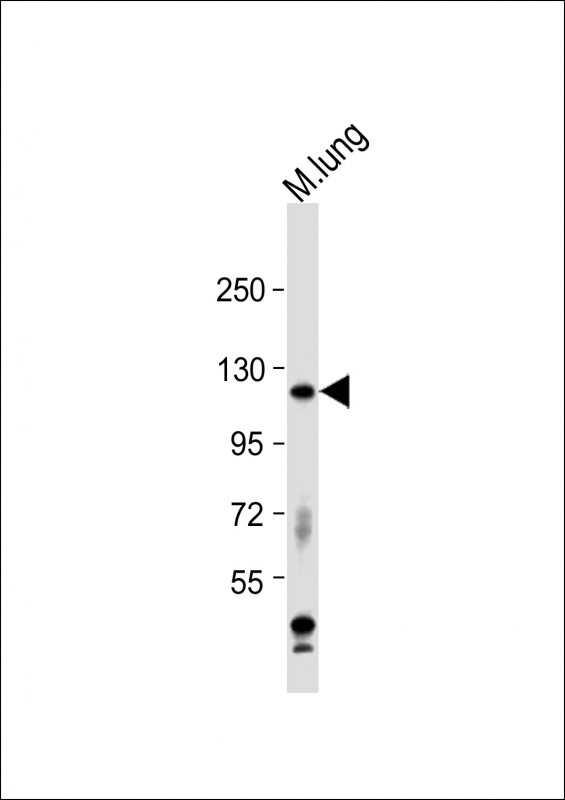Mouse Epha2 Antibody (Center)
Affinity Purified Rabbit Polyclonal Antibody (Pab)
- 产品详情
- 实验流程
- 背景知识
Application
| WB, E |
|---|---|
| Primary Accession | Q03145 |
| Other Accession | NP_034269.2 |
| Reactivity | Mouse |
| Host | Rabbit |
| Clonality | Polyclonal |
| Isotype | Rabbit IgG |
| Calculated MW | 108852 Da |
| Antigen Region | 296-323 aa |
| Gene ID | 13836 |
|---|---|
| Other Names | Ephrin type-A receptor 2, Epithelial cell kinase, Tyrosine-protein kinase receptor ECK, Tyrosine-protein kinase receptor MPK-5, Tyrosine-protein kinase receptor SEK-2, Epha2, Eck, Myk2, Sek2 |
| Target/Specificity | This Mouse Epha2 antibody is generated from rabbits immunized with a KLH conjugated synthetic peptide between 296-323 amino acids from the Central region of mouse Epha2. |
| Dilution | WB~~1:1000 E~~Use at an assay dependent concentration. |
| Format | Purified polyclonal antibody supplied in PBS with 0.09% (W/V) sodium azide. This antibody is purified through a protein A column, followed by peptide affinity purification. |
| Storage | Maintain refrigerated at 2-8°C for up to 2 weeks. For long term storage store at -20°C in small aliquots to prevent freeze-thaw cycles. |
| Precautions | Mouse Epha2 Antibody (Center) is for research use only and not for use in diagnostic or therapeutic procedures. |
| Name | Epha2 |
|---|---|
| Synonyms | Eck, Myk2, Sek2 |
| Function | Receptor tyrosine kinase which binds promiscuously membrane- bound ephrin-A family ligands residing on adjacent cells, leading to contact-dependent bidirectional signaling into neighboring cells. The signaling pathway downstream of the receptor is referred to as forward signaling while the signaling pathway downstream of the ephrin ligand is referred to as reverse signaling. Activated by the ligand ephrin- A1/EFNA1 regulates migration, integrin-mediated adhesion, proliferation and differentiation of cells (PubMed:29749928). Regulates cell adhesion and differentiation through DSG1/desmoglein-1 and inhibition of the ERK1/ERK2 signaling pathway. May also participate in UV radiation- induced apoptosis and have a ligand-independent stimulatory effect on chemotactic cell migration. During development, may function in distinctive aspects of pattern formation and subsequently in development of several fetal tissues. Involved for instance in angiogenesis, in early hindbrain development and epithelial proliferation and branching morphogenesis during mammary gland development. Engaged by the ligand ephrin-A5/EFNA5 may regulate lens fiber cells shape and interactions and be important for lens transparency development and maintenance. With ephrin-A2/EFNA2 may play a role in bone remodeling through regulation of osteoclastogenesis and osteoblastogenesis. |
| Cellular Location | Cell membrane {ECO:0000250|UniProtKB:P29317}; Single-pass type I membrane protein. Cell projection, ruffle membrane {ECO:0000250|UniProtKB:P29317}; Single-pass type I membrane protein. Cell projection, lamellipodium membrane {ECO:0000250|UniProtKB:P29317}; Single-pass type I membrane protein. Cell junction, focal adhesion {ECO:0000250|UniProtKB:P29317}. Note=Present at regions of cell-cell contacts but also at the leading edge of migrating cells. Relocates from the plasma membrane to the cytoplasmic and perinuclear regions in cancer cells. {ECO:0000250|UniProtKB:P29317} |
| Tissue Location | Expressed in the lung, intestine and liver (PubMed:11287184). Expressed in myogenic progenitor cells (PubMed:27446912). |
For Research Use Only. Not For Use In Diagnostic Procedures.
Provided below are standard protocols that you may find useful for product applications.
BACKGROUND
Receptor for members of the ephrin-A family. Binds to ephrin-A1, -A3, -A4 and -A5. Induces apoptosis in a TP53/p53-independent, caspase-8-dependent manner (By similarity). Plays an important role in angiogenesis and tumor neovascularization. The recruitement of VAV2, VAV3 and PI3-kinase p85 subunit by phosphorylated EPHA2 is critical for EFNA1-induced RAC1 GTPase activation and vascular endothelial cell migration and assembly. May function in distinctive aspects of pattern formation and subsequently in development of several fetal tissues. May be involved in cell-cell interactions guiding early hindbrain development.
REFERENCES
Islam, S., et al. Dig. Dis. Sci. 55(9):2478-2488(2010)
Kim, J., et al. Mol. Cell. Biol. 30(7):1582-1592(2010)
Zirzow, S., et al. Dev. Biol. 336(2):145-155(2009)
Jun, G., et al. PLoS Genet. 5 (7), E1000584 (2009) :
North, H.A., et al. Development 136(14):2467-2476(2009)
终于等到您。ABCEPTA(百远生物)抗体产品。
点击下方“我要评价 ”按钮提交您的反馈信息,您的反馈和评价是我们最宝贵的财富之一,
我们将在1-3个工作日内处理您的反馈信息。
如有疑问,联系:0512-88856768 tech-china@abcepta.com.























 癌症的基本特征包括细胞增殖、血管生成、迁移、凋亡逃避机制和细胞永生等。找到癌症发生过程中这些通路的关键标记物和对应的抗体用于检测至关重要。
癌症的基本特征包括细胞增殖、血管生成、迁移、凋亡逃避机制和细胞永生等。找到癌症发生过程中这些通路的关键标记物和对应的抗体用于检测至关重要。 为您推荐一个泛素化位点预测神器——泛素化分析工具,可以为您的蛋白的泛素化位点作出预测和评分。
为您推荐一个泛素化位点预测神器——泛素化分析工具,可以为您的蛋白的泛素化位点作出预测和评分。 细胞自噬受体图形绘图工具为你的蛋白的细胞受体结合位点作出预测和评分,识别结合到自噬通路中的蛋白是非常重要的,便于让我们理解自噬在正常生理、病理过程中的作用,如发育、细胞分化、神经退化性疾病、压力条件下、感染和癌症。
细胞自噬受体图形绘图工具为你的蛋白的细胞受体结合位点作出预测和评分,识别结合到自噬通路中的蛋白是非常重要的,便于让我们理解自噬在正常生理、病理过程中的作用,如发育、细胞分化、神经退化性疾病、压力条件下、感染和癌症。






